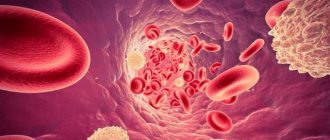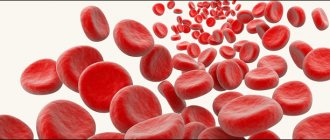How does myeloma develop?
The disease begins with the appearance of altered immune system cells in the body. Normally, it contains several types of cells, including:
- T-lymphocytes, one part of which destroys germs and abnormal cells, and the second helps to increase or slow down the activity of the immune system.
- B lymphocytes, which respond to infection and turn into plasma cells that produce antibodies, or immunoglobulins - proteins that protect the body from bacteria and viruses. Most of them are located in the bone marrow - the soft internal tissues of the bones, in which all types of blood cells are formed:
- Red blood cells that carry oxygen from the lungs to other tissues.
- White blood cells that fight infections.
- Platelets that form clots and stop bleeding.
As a result of the influence of various factors, including obesity, hereditary characteristics, genetic diseases or random failures, plasma cells mutate - change. After which they begin to grow, multiply uncontrollably and disrupt normal hematopoiesis - the creation of red blood cells, leukocytes and platelets. In addition, they produce antibodies - a special protein M-protein, or paraprotein, which is not able to participate in the work of the immune system and protect the body. Over time, there are more of them, they turn into a tumor - plasmacytoma, or multiple myeloma - several similar neoplasms in different parts of the body.
Abnormal cells accumulate in organs, including the kidneys and liver, which reduces the release of blood-thinning compounds and disrupts tissue metabolism. They also destroy bones, from which calcium is released, which leads to serious consequences - from fractures and pain to the development of coma - an unconscious state.
Complications
From the bone marrow, the disease quickly spreads to the bones, causing fractures and deformities. Compression of the spinal cord is possible, which is accompanied by paralysis of the corresponding limbs. Bleeding increases. In later stages of the disease, patients begin to experience functional impairment in the kidneys. Renal failure and proteinuria develop, and the filtration capacity of the organ decreases. This leads to disability and death. After diagnosis, subject to appropriate treatment, the life expectancy of patients is 2–2.5 years, with a maximum of up to 10 years.
Cause of myeloma
Doctors and scientists do not know the exact reasons for its occurrence - they only know factors that increase the likelihood of this event:
- The older the person, the higher his risks - in most cases, the disease is detected in people at least 65 years of age. It can also develop in young people, but it is quite rare - in less than 1% of all cases it is detected before the age of 35. The average age
of patients is 66-70 years. - Genetics
. Having blood relatives with myeloma - parents, children, brothers or sisters - increases the chances of similar tumors developing in their family members. - Similar factors include gender
- the chances of this type of cancer occurring in men are slightly higher than in women. To date, the reasons for this difference are not known to doctors. - Obesity
. People who are overweight are at increased risk of developing certain types of dangerous tumors, including myeloma, pancreatic, prostate, kidney, gallbladder, colon, endometrial, esophageal, ovarian, cervical and breast cancer. The higher a person's body mass index is, body mass index is equal to weight in kilograms divided by the square of height in meters. BMI = kg/m2., the more likely he is to develop a dangerous neoplasm. Obesity leads to increased inflammation in the body, causes blood vessels to grow, and also changes the levels of various hormones that can promote the proliferation of altered cells. - Race
: Black people are twice as likely to have myeloma than other races. - In fairly rare cases, the likelihood of developing cancer increases due to exposure to X-rays or other types of radiation
.
Having other plasma cell diseases also increases your risks. These include:
- Monoclonal gammopathy of unknown origin is the presence of abnormal plasma cells in the bone marrow that produce an abnormal protein. It disrupts the functioning of various tissues and systems, such as the kidneys. People with this condition often have no symptoms, but in some cases it can develop into myeloma.
- Solitary plasmacytoma is a tumor consisting of altered plasma cells, located either in the bone or in other organs, for example, in the digestive system or respiratory tract. Approximately 65-84% of its cases degenerate into oncology within 10 years.
Who is at risk for multiple myeloma?
- People over 60 years of age;
- People suffering from obesity;
- People who have been exposed to radiation;
- People who worked with pesticides, insecticides, petroleum products, and other toxic substances;
- People whose relatives suffered from multiple myeloma;
- Patients suffering from HIV infection;
- Patients suffering from monoclonal gammopathy (a group of diseases in which the human body begins to produce
- abnormal antibodies);
- Patients suffering from autoimmune diseases (for example, systemic lupus erythematosus or rheumatoid arthritis).
Symptoms and signs of myeloma
As a rule, the disease is rarely detected in the early stages, since it usually does not bother its owner until the lesions become quite serious. Symptoms of myeloma may look like this:
Bone problems
:
- Pain in any area of the body, but most often in the back, hips and skull.
- Osteoporosis is a decrease in bone density and disruption of its structure due to leaching of calcium from it - throughout the body or only in the place where the tumor is located.
- Fractures that occur due to minor trauma or light load.
Low blood counts
:
- Anemia: a reduced number of oxygen-carrying cells, which leads to weakness, inability to tolerate normal and habitual exercise, dizziness and shortness of breath - a feeling of lack of air.
- Thrombocytopenia: A lack of clot-forming platelets can cause severe bleeding from even minor abrasions, cuts or bruises.
- Leukopenia: a lack of white blood cells that protect us reduces resistance to various infections.
Hypercalcemia – high levels of calcium in the blood
due to its release from the bones:
- Intense thirst.
- Frequent urination.
- Dehydration.
- Problems with the kidneys, up to failure - organ failure.
- Severe constipation.
- Stomach ache.
- Loss of appetite.
- Weakness.
- Drowsiness.
- Confusion.
- If calcium levels rise critically, a person may even fall into a coma - an unconscious state.
Damage to the nervous system
. Weakened bones in the spine can become brittle, rupture, and put pressure on nerves, causing:
- sudden severe back pain;
- numbness, usually in the legs;
- muscle weakness, usually in the lower extremities.
Some proteins produced by myeloma cells are toxic - poisonous to nerves
. Their defeat can also lead to weakness, numbness and a tingling sensation.
In some patients, excess of these substances leads to “thickening” of the blood
–
increasing
its
viscosity
. This condition slows the flow of this vital fluid to the brain and can cause dizziness, confusion and the development of stroke symptoms. A stroke is an acute problem of blood circulation in the brain - muscle weakness on one side of the body and slurred speech.
In addition, altered proteins damage the kidneys
. In the early stages of the disease, this does not cause any symptoms, but signs of their damage can be seen in blood or urine tests. When these organs begin to fail, they stop removing excess salt, fluid, and waste products from the body, resulting in weakness, itching, difficulty breathing, and swelling of the legs.
Myeloma patients often suffer from various infections
, most often from pneumonia - inflammation of the lungs, usually respond poorly to treatment and take a long time to recover.
Diagnosis of myeloma
Examination is a very important process for any patient, since during it doctors do not just identify the disease. They find out how seriously the body has been damaged and provide approximate prognoses for the patient, which allows them to select the most appropriate therapy in each specific case.
A complete diagnosis of myeloma can be done in an oncology department. We have the most modern equipment, our own laboratory and all the necessary specialists - candidates and doctors of medical sciences with extensive experience. There are no queues in our center, all procedures are carried out on time, and the studies performed by us do not have to be redone - their results are trusted by all medical institutions.
The examination begins with blood and urine tests
and measuring quantities in them:
- Red blood cells, white blood cells and platelets, the level of which can drop if too many changed cells accumulate. Most often, patients are diagnosed with anemia - a lack of red blood cells.
- Creatinine is a substance formed during protein metabolism. When the kidneys are damaged, there is more of it in the body, and the prospects for recovery worsen.
- Albumin is a protein that maintains pressure, delivers various chemical compounds to tissues and is involved in metabolism. Its amount is often reduced in patients with myeloma.
- Calcium, the amount of which increases with the destruction of bones.
- Antibodies, or immunoglobulins, are proteins that protect the body from bacteria and viruses: IgA, IgD, IgE, IgG and IgM. Levels of some types of these substances may be very high, while others may be extremely low.
- Analysis to determine the type of altered antibodies - M-protein or paraprotein.
- b2-microglobulin is a protein present on the surface of almost all cells of the body. Its content in the blood increases during inflammatory processes, myeloma, lymphoma and some other diseases.
- Bence Jones protein secreted by tumor cells.
- A 24-hour urine test showing the amount of myeloma protein and the quality of kidney function.
Doctors perform a biopsy
– take a small amount of it with a needle and transfer the sample to the laboratory for testing.
X-ray
– Helps detect bone destruction.
Computed tomography
is performed for the same purpose - during scanning, a special device creates a clear image and allows you to study in detail the damage to parts of the skeleton.
Magnetic resonance imaging, MRI
– shows in detail the condition of soft tissues, brain, bone and spinal cord. MRI detects even those plasmacytomasA plasmacytoma is a tumor consisting of altered plasmacytes - cells that produce antibodies - proteins that protect the body from bacteria and viruses, which cannot be seen on a regular x-ray.
Positron emission tomography, PET
. The study is carried out after the patient takes a small dose of radioactive sugar, which can accumulate in dangerous cells. The method does not provide a clear “picture” of the internal organs, but allows one to detect any foci of the disease in all areas of the body.
Stages of myeloma
Immediately after identifying the disease, doctors determine its stage - they find out how seriously the body has suffered. They need this information to provide approximate prognoses for the patient and select the most suitable treatment for him.
Myeloma staging is based on 4 factors:
- albumin
in the blood is a protein that maintains pressure, delivers various chemical compounds to tissues and is involved in metabolism. - b2-microglobulin
in the blood is a protein present on the surface of almost all cells of the body. Its content in the blood increases during inflammatory processes, myeloma, lymphoma and some other diseases. - The amount in the blood of LDH, lactate dehydrogenase
, a protein found in almost all cells of the body that is involved in the production of energy from glucose. - Cytogenetic abnormalities
in altered cells: incorrect number or disruption of the structure of chromosomes, each of which represents one DNA molecule storing genetic material. Such changes may mean a worsening prognosis. For example, the loss of part of chromosome 17, as well as the exchange of material between 4 and 14, or between 14 and 16, are considered high-risk because they significantly worsen the patient's prospects. All other anomalies are classified as standard risk.
In total, doctors distinguish 3 stages of myeloma
:
I:
Albumin
level 3.5 grams/deciliter 1 deciliter = 100 cubic centimeters, or 1/10 of a liter or higher,
b2-microglobulin
less than 3.5 mg/l,
normal LDH
II:
The second stage of the disease includes all conditions whose indicators cannot be attributed to stages I or III.
III
B2-microglobulin
level is 5.5 mg/L or more, high-risk cytogenetic abnormalities, and/or high
LDH
.
List of sources
- Mendeleeva L.P., Votyakova O.M., Rekhtina I.G. Multiple myeloma. Russian clinical guidelines for the diagnosis and treatment of malignant lymphoproliferative diseases. Ed. I.V. Poddubnoy, V. G. Savchenko. M., 2021. P.: 213–41.
- Bessmeltsev S.S. Multiple myeloma (pathogenesis, clinical picture, diagnosis, differential diagnosis) // Clinical oncohematology. — 2013.— T6, No. 3.— P. 237-257.
- Bessmeltsev S.S., Abdukadyrov K.M. Multiple myeloma. A modern view of the problem. Almaty, 2007.
- Moiseev S.I., Salogub G.N., Stepanova N.V. Modern principles of diagnosis and treatment of multiple myeloma. – St. Petersburg: St. Petersburg State Medical University Publishing House, 2006. – 39 p.
- Votyakova O.M. Multiple myeloma: achievements of drug treatment of the XXXXI centuries // Oncohematology. – 2004. – T. 6, No. 4 – P. 1925.
Myeloma treatment
The fight against myeloma is a complex task that requires the participation of many doctors of various specialties: oncologist, chemotherapy, neurologist, urologist and others. The more information about the state of the body and the course of the disease they receive from each other, the more factors they are able to take into account.
The oncology department provides complete diagnosis and any treatment for myeloma. We consider each case individually - all our patients receive therapy prescribed by the decision of a council of doctors, candidates and doctors of medical sciences with extensive experience. This approach allows us to select the best options for influencing altered cells and causing minimal harm to healthy tissues. We use only the most modern equipment and original drugs that give predictable results. With us you don’t have to waste time - examination and treatment are carried out with us without queues or delays, just on time.
Doctors use several methods to treat myeloma:
Drug therapy
Chemotherapy
is the destruction or prevention of the growth of altered cells using special drugs.
These include: Cyclophosphamide, Etoposide, Doxorubicin, Melphalan and Bendamustine. They enter the bloodstream and reach almost all areas of the case, affecting any foci of the disease. Corticosteroids
, powerful anti-inflammatory drugs such as Dexamethasone and Prednisolone, are an important part of therapy.
They can be used alone or in combination with other medications. Immunomodulators
are substances that affect a person’s own immune system and help it fight the disease: Lenalidomide and Pomalidomide.
Proteasome inhibitors
- prevent the breakdown of proteins necessary for cell division: Bortezomib, Carfilzomib and Ixazomib.
Histone deacetylase inhibitors
, such as Panobinostat, affect the activity of certain genes in cells.
Monoclonal antibodies
:
substances artificially designed to attack a specific target—for example, proteins on the surface of myeloma cells. These include Daratumumab and Elotuzumab. Bisphosphonates
are medications that slow down the weakening of bones and reduce pain in them: Pamidronate. Zoledronic acid and Denosumab.
Stem cell transplantation
– a bone marrow transplant, whose cells can become red blood cells that carry oxygen throughout the body, white blood cells that help fight infections, and platelets that stop bleeding. First, the patient is given high-dose chemotherapy, which destroys the damaged bone marrow, after which new, healthy hematopoietic cells are injected. Transplantation can be autologous - using pre-collected own material, or allogeneic - using cells from another person - a donor.
Radiation therapy
: destruction of foci of disease using radiation is one of the most suitable options for combating single plasmacytomas. Plasmacytoma is a tumor consisting of altered plasmacytes - cells that produce antibodies - proteins that protect the body from bacteria and viruses.. It is used to treat areas of bones damaged by myeloma that have not responded to chemotherapy or other drugs are painful or may break down.
IVIG
maintenance therapy is the intravenous administration of normal antibodies - immunoglobulin proteins necessary to fight infection.
Erythropoietin
is a drug that increases the number of red blood cells that carry oxygen from the lungs to other tissues.
Plasmapheresis
is a procedure that removes myeloma proteins and reduces blood viscosity.
7th course of chemotherapy for a rare disease - myeloma.
Diet
Diet 15 table
- Efficacy: therapeutic effect after 2 weeks
- Timing: constantly
- Cost of food: 1600-1800 rubles per week
Nutrition for this disease must be complete in essential nutrients and have sufficient energy value. Complete protein in sufficient quantities is important in the diet (beef, poultry, rabbit, turkey, liver, fish, cottage cheese). The patient should receive 2 grams of protein per kilogram of weight daily.
Steamed meatballs, meatballs or cutlets are prepared from meat products. Sources of calcium include fermented milk products, cottage cheese, sunflower and sesame seeds. The daily diet should include foods containing vitamins B and C, and, taking into account anemia, foods rich in iron (beef, beef liver, pomegranate). Meals should be fractional - small portions for better digestion and to avoid digestive overload.
Simple carbohydrates are excluded, since taking dexamethasone and prednisolone may increase sugar levels. You should not eat fatty, fried and spicy foods, fatty milk and cream, rich soups, smoked foods, canned food and pickles. During the period of remission, nutrition can be more varied and strict restrictions are not provided. Vitamins and microelements are still important in the diet, the sources of which are green vegetables, fruits, flaxseed and olive oil, fish oil, and a variety of nuts.







